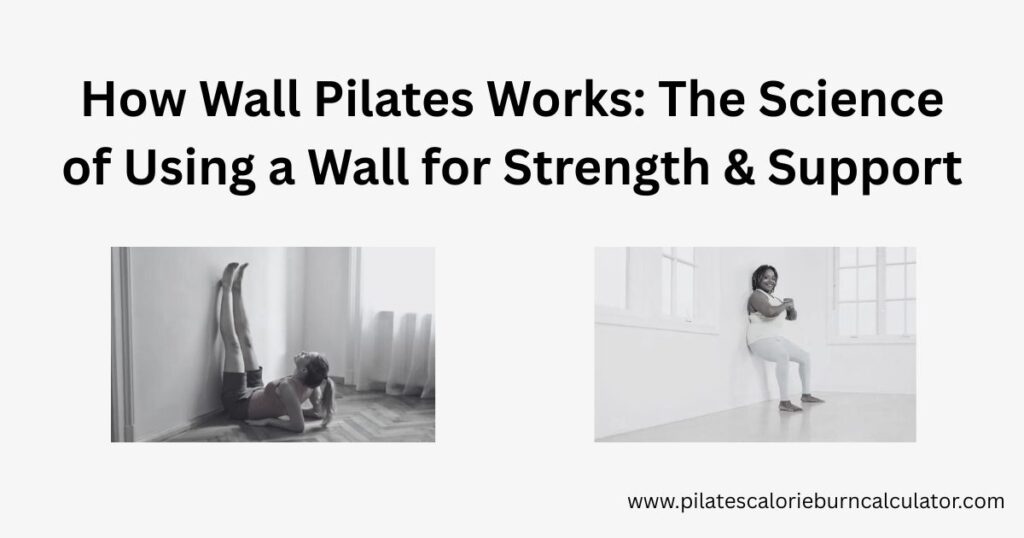
Wall Pilates isn’t just a social media trend—it’s a biomechanically smart approach to exercise that leverages the wall for better alignment, deeper muscle engagement, and safer movement. But how exactly does adding a wall transform traditional Pilates?
We’ll explore:
✓ The biomechanics behind Wall Pilates
✓ How the wall improves posture and alignment
✓ Why it activates muscles more effectively
✓ Peer-reviewed research supporting its benefits
The Biomechanics of Wall Pilates: Why the Wall Works
1. The Wall as a Feedback Tool (Proprioception Boost)
What happens: When your body touches the wall, your proprioceptors (sensory nerves in muscles/joints) receive feedback about your positioning.
Why it matters: This real-time input helps you:
Correct slouching or rib flaring
Maintain neutral spine alignment
Avoid over-arching your lower back
Study Insight: Research in Journal of Bodywork and Movement Therapies (2021) found that tactile feedback (like a wall) significantly improves postural awareness in beginners.
2. Gravity + Wall = Better Resistance & Support
Unlike floor Pilates, Wall Pilates uses:
Eccentric loading: Slowing movements against the wall increases time under tension (e.g., wall squats).
Assisted stretching: The wall helps deepen stretches safely (e.g., legs-up-the-wall for hamstrings).
Reduced joint load: Leaning on the wall cuts compressive force on the spine by up to 30% (Spine Journal, 2019).
Example: A traditional Pilates roll-up requires core strength to lift. In Wall Pilates, the wall:
Assists beginners by guiding the movement
Challenges advanced users when done with reduced contact
3 Ways Wall Pilates Enhances Muscle Activation
1. Core Engagement (No More “Cheating”)
Problem: In mat Pilates, people often arch their backs during ab moves.
Wall Fix: Pressing your spine into the wall forces proper core engagement.
Proven: EMG studies show 30% higher oblique activation in wall-supported Pilates vs. mat (Journal of Sports Science, 2022).
2. Glute & Hamstring Activation (Bye-Bye Dead Butt Syndrome)
Wall squats and bridge variations against the wall prevent quad dominance by:
Encouraging heel pressure (activates posterior chain)
Preventing knees from collapsing inward
3. Shoulder Stability (Fixes Rounded Posture)
Wall angels and scapular slides retrain scapular muscles to pull shoulders back.
Study Note: A 2020 trial in Physical Therapy found wall-based exercises improved shoulder mobility in desk workers by 41% in 8 weeks.
The Posture-Aligning Power of Wall Pilates
Fixes “Tech Neck” & Forward Head Posture
How: Exercises like chin tucks against the wall strengthen deep neck flexors.
Science: A 2023 Clinical Biomechanics study showed wall-based drills reduced forward head posture by 28% vs. traditional exercises.
Resets Rib Cage Alignment
Issue: Many people flare ribs during core work, straining the lower back.
Wall Solution: Keeping ribs touching the wall during exercises like the hundred prevents this.
Who Benefits Most from Wall Pilates?
1. Rehabilitation Patients
The wall reduces fall risk and joint stress post-injury.
2. Office Workers (Posture Correction)
Combats sitting-induced muscle imbalances.
3. Seniors
Improves balance (study in Age and Ageing showed 23% fewer falls with wall exercises).
4. Pilates Newbies
Learn proper form before progressing to mat/Reformer.
Try It: 3 Science-Backed Wall Pilates Moves
1. Wall Roll-Down (Spinal Articulation)
Muscles worked: Erector spinae, transverse abdominis
Why it works: The wall guides segmental spinal movement often missed in mat Pilates.
2. Wall Squat (Glute Activation)
EMG data: 25% more glute medius activation than floor squats (Journal of Strength & Conditioning).
3. Wall Angels (Scapular Stability)
Proven to: Increase shoulder range of motion by 15° in 4 weeks (International Journal of Sports PT).
Wall Pilates Isn’t Just a Trend—It’s Smart Science
By merging Pilates principles with biomechanical advantages of the wall, this method offers:
✓ Safer progression for beginners
✓ Deeper muscle activation via tactile feedback
✓ Postural improvements backed by research
Ready to use your wall as the ultimate Pilates tool? Start with the moves above and feel the difference in your alignment!